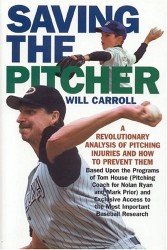Saving the Pitcher


| Click on a book's image or title to order from Amazon.com |

Saving the Pitcher
by Will CarrollIvan R. Dee, HC, © 2004, 186 pp, ISBN #1-56663-578-0
Reviewed September 2004
When Will Carroll started writing for the Baseball Prospectus, I found myself disappointed that he wasn't bringing a more sabermetric approach to the study of his topic: injuries and medical issues in baseball. Two years later, I enjoy his writings a lot more, but more as a source of knowledgeable data about specific players than for bringing a true analytical approach to the subject.
His book, Saving the Pitcher, is in exactly the same vein: As a source of detailed information about how pitching works, it's a treasure trove. As a source of analysis of pitching and pitching injuries, I find it wanting. And weighing in at a mere 186 pages (plus appendix and index), it feels like it could have been much more while not losing readability (though, to be fair, it would have required a lot more research).
The book's goal is simple and laudable: Pitchers in baseball often get hurt, at all levels of the game, and Carroll wants to see them get hurt less often, wants to explain how they can pitch less injuriously, and wants to inform baseball's fans and pros so they can all contribute in whatever ways they can to bring about this goal.
The true meat of the book comes in chapters 3 and 4, "The Functional Anatomy of Pitching" and "The Functional Mechanics of Pitching". The former describes the parts of the body which contribute to throwing a pitch - in particular, to imparting velocity to the ball: The legs, hips, back, shoulder, arm, and hand. Although not always described in layman's terms, there's plenty of information here explaining why things work the way they do, and the latter chapter describes how the pitcher can throw to most effectively and efficiently hurl the ball at top speed.
The central theorem of Carroll's book seemed to be only implicitly stated: That a pitcher with ideal mechanics will also be a less risk of injury. Or, to state it a different way, the same mechanics which allow a pitcher to throw a ball with the most force also minimize the risk of injury to the pitcher. This seems intuitive. But is it correct? In all the discussion of pitching mechanics, attention is given to how certain sorts of mechanical flaws will lead to injury, but he never really puts it all together: Does every mechanical flaw both increase risk of injury and decrease velocity? Is fixing any such flaw to the benefit of both velocity and health? Or will some corrections - even once fully mastered - result in better health but lesser velocity? Ultimately, I wasn't persuaded that healthy mechanics and effective mechanics are necessarily always the same.
What Saving the Pitcher really lacks are examples and data - exactly the sorts of things sabermetricians are most looking for. A consideration of the many pitchers who have had long, healthy careers - Nolan Ryan, Roger Clemens, Greg Maddux - and evaluating their mechanics would have been welcome. An examination of a number of pitchers with good mechanics - or differing varieties of bad mechanics - and their ability to stay healthy.
Carroll wisely notes that organizations who have an effective pitcher with dangerous mechanics need to choose between riding his success until he gets hurt, or trying to help him correct his mechanics. While this is followed by an informative explanation of common flaws and the injuries they can result in, case studies would have been appreciated. Reportedly Roy Halladay re-worked his mechanics before becoming a Cy Young Award winner, but surely there have been pitchers who have re-worked their mechanics yet been less effective afterwards (or have there?). What are the organization's moral and success-based imperatives if a successful but risky pitcher has a good chance of ending up healthy but lousy? Carroll strangely takes up a large amount of space to explain some sabermetric truths: That the pitcher's Win and Save stats are largely useless, that Bill James has produced a groundbreaking study of how best to deploy ace relievers in a game. He also breaks down Eric Gagne's amazing 2003 season and presents a new statistic, Perfection Percentage, which measures the number of batters a pitcher has faced per inning pitched. However, I couldn't see how any of these discussions really brought us any closer to making pitchers healthier and more effective. How does it help us "save the pitcher"? Certainly, facing fewer batters and thus throwing fewer pitches would surely help, but this is easier said than done.
Other than the raw data, the true games of the book are a few brief comments mentioned almost offhandedly:
- Teams should be motivated to save pitchers because not doing so costs them money - money at the gate due to lost wins, and money directly from their pocketbook due to huge contracts;
- The one advantage a tall pitcher has over a short pitcher is that he actually releases the ball closer to the plate;
- Loss of velocity is a useful measure of pitcher fatigue - arguably more useful than pitch counts - and laymen can usefully discern loss of velocity with their eyeballs, even without a radar gun.
hits since 14 September 2004.